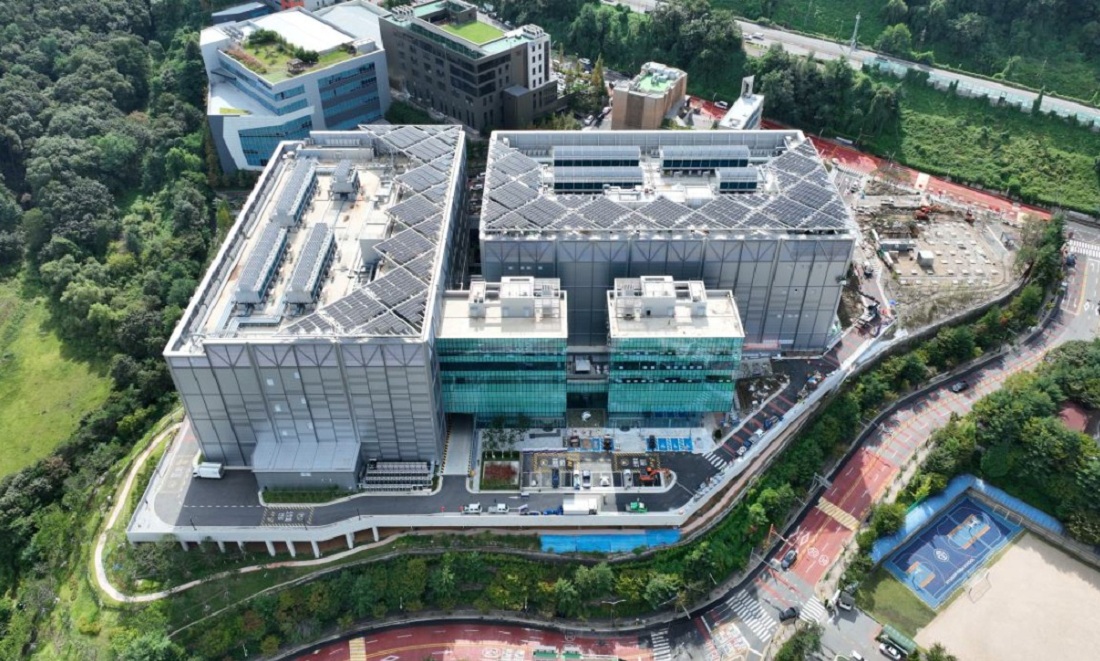Press Release
Ushering in the Era of Korea’s Largest Hyperscale Data Center
▲ Completes the Pacific Sunny Data Center in Yongin, the largest in Korea with a capacity of 64MW, securing both stability and efficiency
▲ Will continue to expand the construction of eco-friendly and customized data centers to meet the demands of the AI and cloud industries

Hyundai E&C is accelerating the expansion of digital infrastructure and the establishment of a foundation to help support the AI industry, ushering in the era of Korea’s largest hyperscale data center.
Hyundai E&C announced on Friday, November 24th, that it has recently completed construction of the Pacific Sunny Data Center located in Jukjeon, Yongin-si, Gyeonggi-do Province. This project, commissioned by Pacific Asset Management and jointly invested in by the Canada Pension Plan Investment Board (CPPIB) and Shinhan Financial Investment, is a venture with a total value of KRW 1.3 trillion. Two data center buildings and ancillary facilities have been constructed on a site with a total floor area of 99,125 m² (approximately 30,000 pyeong).
The Pacific Sunny Data Center in Jukjeon, Yongin is a mega-scale data center in Korea, equipped with a power infrastructure featuring an IT Load1) of 64MW and a power receiving capacity of 100MW. This amount of electricity is equivalent to what approximately 160,000 to 200,000 households might use in a single day. To meet the demands of an industrial environment where High-Performance Computing (HPC) needs for the cloud, internet, and information and communication are soaring, the center has been designed with a structure capable of high-density operations of 10kW or more.
In addition, it has been built with a carrier-neutral architecture, independent of any single telecommunications provider, thereby establishing an open data infrastructure that can accommodate the traffic demands of a wide array of global operators. Based on its geographical advantage of being adjacent to the Pangyo region, it is expected to emerge as a central hub of the digital network that covers the southern part of the Seoul metropolitan area.
The Pacific Sunny Data Center, completed approximately 43 months after the start of construction in February 2022, was successfully finished thanks to specialized process management capabilities and construction technology innovation. Notably, the Strut-Top-Down (STD) method, which allows for parallel execution of underground excavation and above-ground framework, was incorporated in light of the constrained urban site conditions,. By precisely integrating and managing complex facility, power, and piping processes through pre-construction services, building information modelling (BIM)-based interference minimization design, and fast-track project implementation, the time required for construction was effectively minimized while ensuring quality and safety.
Hyundai E&C has maximized the energy efficiency and operational stability of the Pacific Sunny Data Center through advanced facility control technology and an energy-saving operations system. By introducing a high-efficiency cooling system, pre-cooling technology, and a real-time energy monitoring system, it has achieved an industry-leading Power Usage Effectiveness (PUE2)) of 1.3. This level, which meets the operational standards of global cloud vendors, is regarded as an eco-friendly energy solution that minimizes power loss and reduces carbon emissions during the operational phase.
Moreover, a highly reliable infrastructure capable of 24/7 uninterrupted operation has been set up, satisfying the international certification standard of Tier III or higher for stability and security. Key sections of the data center, including emergency generators, uninterruptible power supply systems (UPS), and chillers, have been designed with dual and triple redundancy, ensuring completely uninterrupted operations where if one line is interrupted, another steps up to immediately supply the necessary power.
A Hyundai E&C official noted, “The completion of the Pacific Sunny Data Center in Jukjeon, Yongin is a prime example of our capability to build stable and efficient infrastructure amid the advancement of the digital industry.” The official added, “We will expand our digital infrastructure network, centering on key locations in the Seoul metropolitan area, and continue to develop eco-friendly data center models that respond to the demands of the AI and cloud industries.”
Hyundai E&C has constructed the largest number of data centers among Korean construction companies, starting with the Korea Financial Telecommunications & Clearings Institute's Bundang Center in 2004, and including the KT Mokdong IDC, Naver's GAK Sejong Data Center, and the K Square Data Center Gasan. It is also the only Korean company to have built a data center for a global big-tech leader, thereby proving its global-standard technological prowess and expertise. Moving forward, Hyundai E&C plans to simultaneously realize the construction of core infrastructure for the AI era and energy innovation through the development of eco-friendly and small modular reactor (SMR)-linked data center models tailored to the energy source characteristics of each region.
1) The amount of power used within a data center to operate IT equipment such as servers and network devices in performing their core functions.
2) An international standard indicator that represents the energy efficiency of a data center—the lower the value, the higher the energy efficiency.


